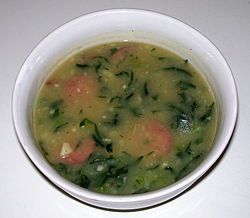
Back Kaldu Verde Azerbaijani Caldo verde German Caldo verde (cocina portuguesa) Spanish Caldo verde Basque Caldo verde French Caldo verde Galician קאלדו ורדה HE Կալդու վերդե Armenian Caldo verde Italian カルド・ヴェルデ Japanese
 | |
| Type | Soup |
|---|---|
| Place of origin | Portugal |
| Region or state | Minho Province |
| Main ingredients | Portuguese cabbage, potatoes |


Caldo verde (pronounced [ˈkaldu ˈveɾðɨ], Portuguese for "green broth") is a popular soup in Portuguese cuisine.[1]
The basic traditional ingredients for caldo verde are julienned Portuguese cabbage or couve-galega (essentially a type of collard green), (or alternatively other leafy greens such as kale or mustard greens), potatoes, olive oil, black pepper and salt, mainly flavoured with onion and garlic.[2][3] Some regional recipes favour slight variations, like turnip greens or added meat, such as ham hock, making it similar to Italo-American wedding soup. Traditionally, the soup is accompanied by slices of paio, chouriço or linguiça (boiled whole with the potatoes, then sliced and added to the finished soup when serving) and with Portuguese broa corn-bread or rye-bread on the side for dipping.[4] In Brazil, the soup is accompanied by Pão francês, similarly to virtually all kinds of soups.[5] In Portugal, caldo verde is typically consumed during events such as weddings, birthdays and popular celebrations. It is sometimes consumed before a main course or as a late supper. It is traditionally served in earthenware bowls called tigela.[6]
- ^ Ilídio Lacerda (December 2009). The Secrets of Portuguese Cookery. BoD – Books on Demand. pp. 31–. ISBN 978-3-8391-4529-6. Retrieved 24 August 2013.
- ^ The Illustrated Cook's Book of Ingredients. DK Publishing. 2010. p. 193. ISBN 978-0-7566-7673-5. Retrieved 2 April 2017.
- ^ "Portuguese Caldo Verde with Broa de Milho". The San Diego Participant Observer. Archived from the original on 31 May 2021. Retrieved 23 June 2020.
- ^ Crescent Dragonwagon (2007). The Cornbread Gospels. Workman Publishing. pp. 103–. ISBN 978-0-7611-1916-6. Retrieved 24 August 2013.
- ^ Pereira, Luciano. "French Rolls Popular in Brazil". World-grain.com. Retrieved 5 February 2024.
- ^ "Na Cozinha do Vítor: Caldo Verde". 16 March 2019.